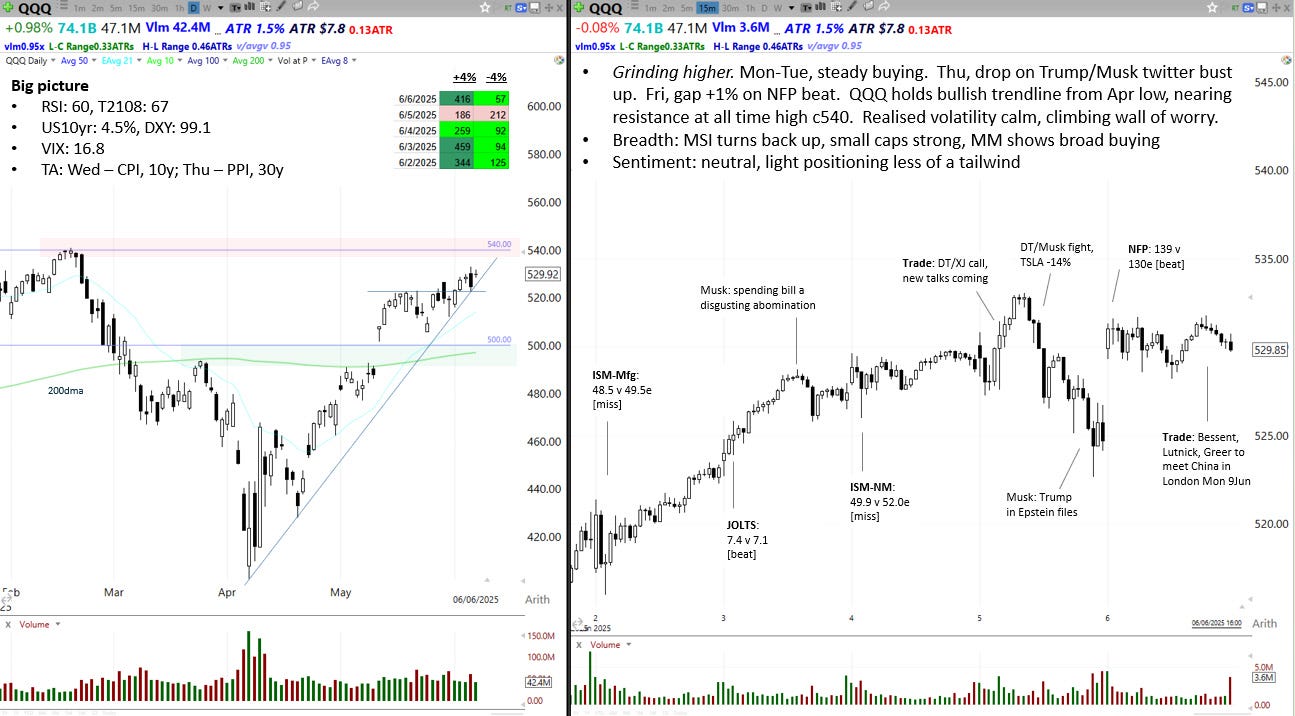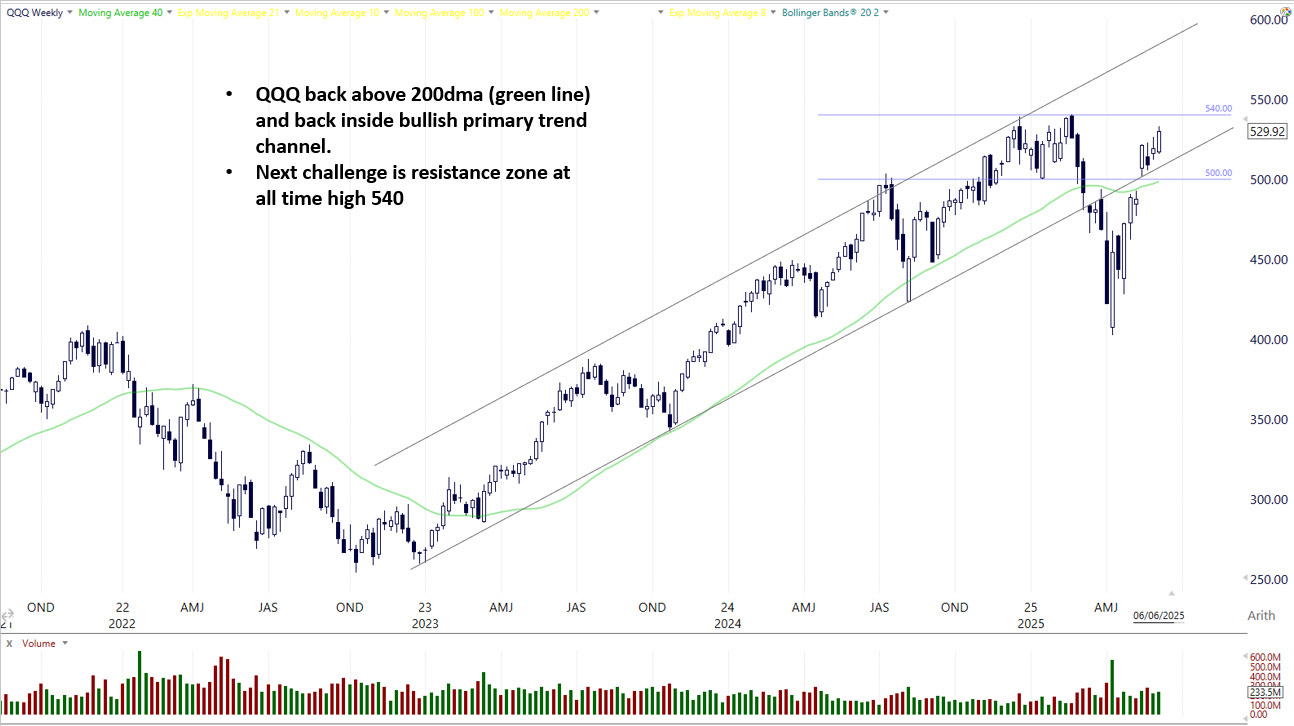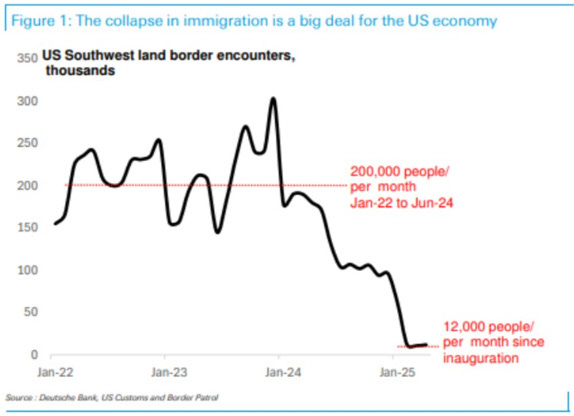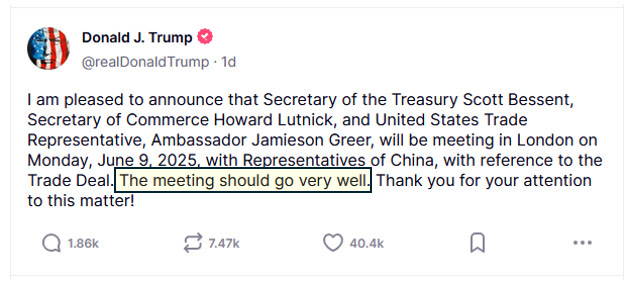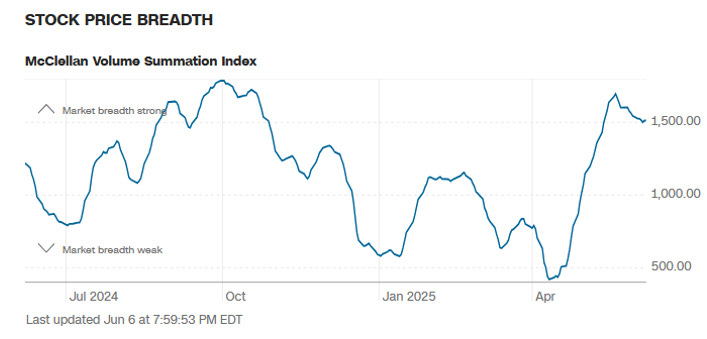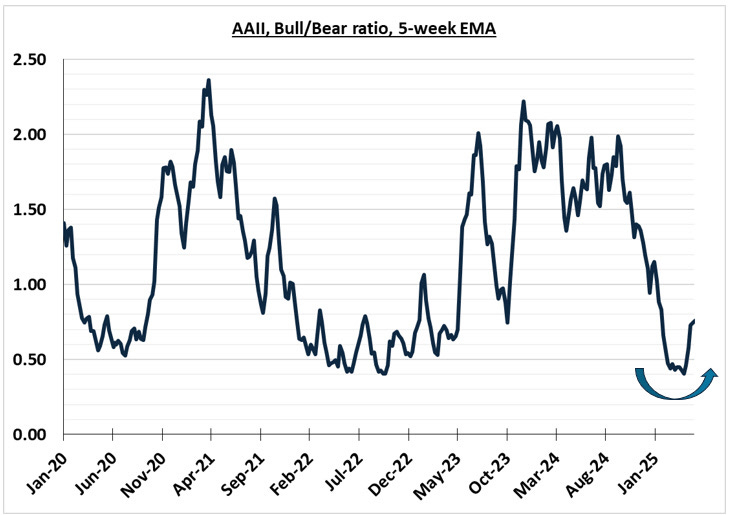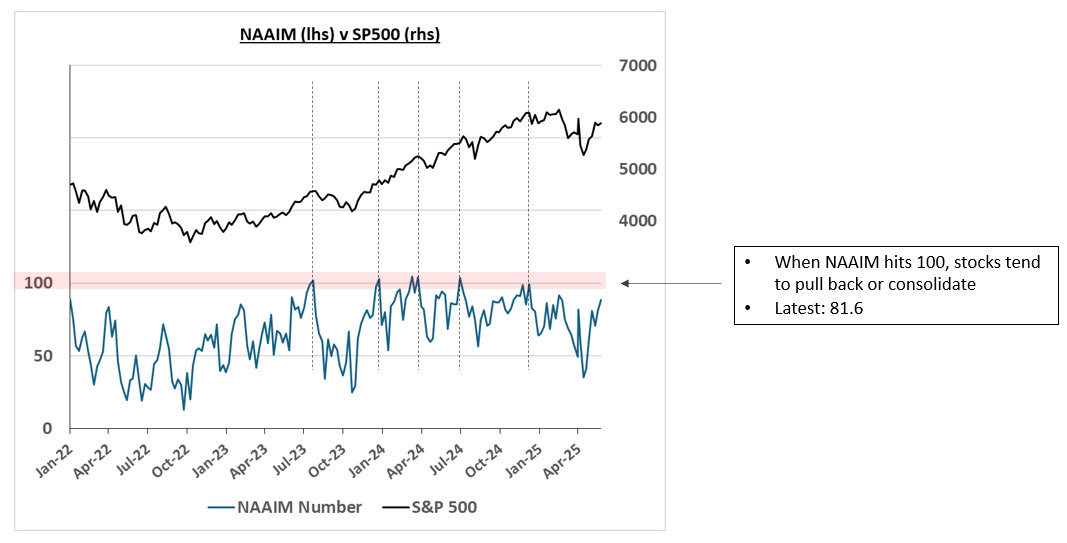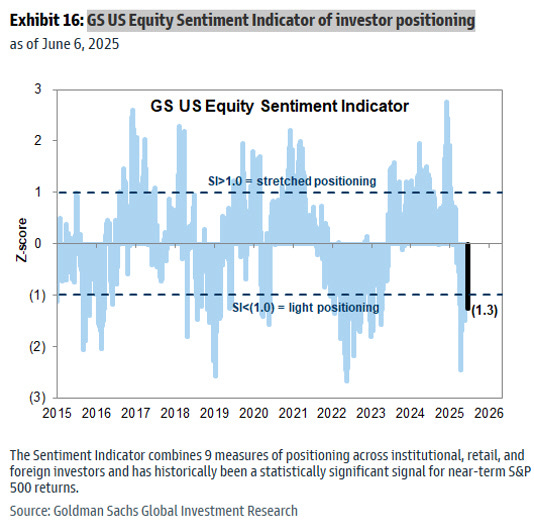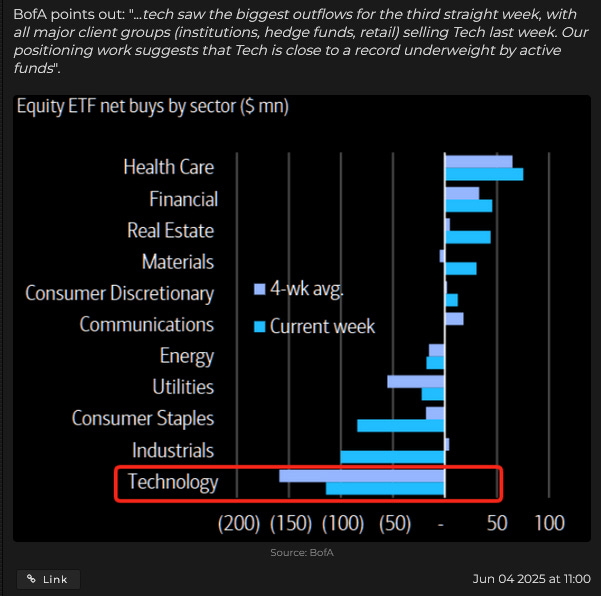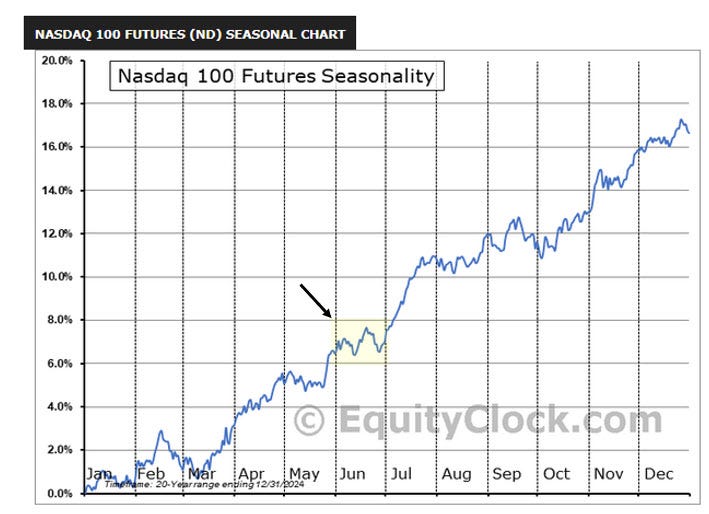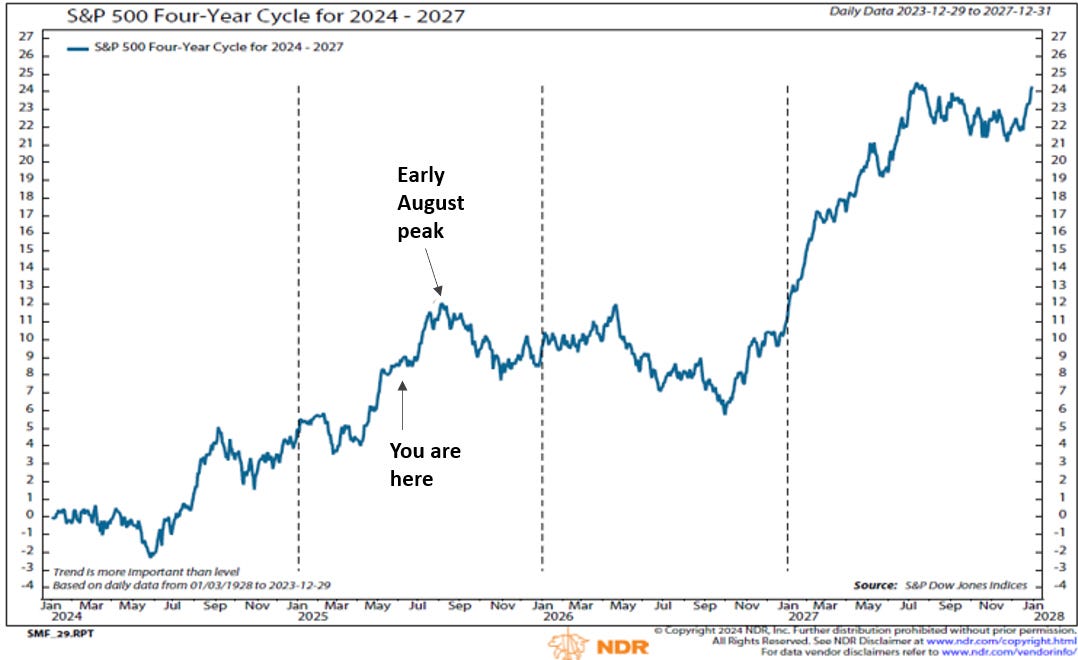Price action
QQQ continues to do what it does best, namely climb a wall of worry. There was a brief bout of volatility on Thursday as Trump and Musk fell out on social media. On Tuesday, Musk tweeted that Trump’s signature Big Beautiful Bill is a “pork-filled disgusting abomination”. On Thursday, the pair exchanged increasingly heated tweets, which culminated in Musk stating Trump hasn’t released the Epstein files because Trump is named in them. TSLA fell -17.6% intraday before bouncing a little. At a 2.6% weighting in the Nasdaq100, at one point TSLA on its own knocked QQQ down -0.46%.
On Friday, QQQ recovered as Non Farm Payrolls came in above consensus estimates, which was a relief after somewhat weak ISM surveys.
QQQ continues to hold above its 200dma, while realised volatility continues to ease back. Both of these are constructive indications that bull market conditions have returned. QQQ is not technically overbought, but we’re now bumping into a clear resistance zone at the all time high around 540. This may prove a tough nut to crack first try. A -6% pullback to the 200dma would provide an attractive entry point for investors who missed the bounce off the April low. However, a break above 540 may prompt a chase as QQQ makes new all time highs.
The Fed
This week’s FOMC speakers delivered the same message we’ve heard for months:
Cautious optimism on inflation progress, but significant concern about tariff-driven upside inflation risks.
Support for holding rates unchanged until there is more clarity about the impact of government policy on prices and jobs.
Dual mandate tension is re-emerging with inflation risks rising and jobs maybe softening.
Besides the messaging above, Adriana Kugler, a member of the Federal Reserve Board of Governors, raised another theme that’s been drowned out by tariff noise:
“Declining net immigration could tighten the labour market, with possible sector-specific impacts emerging by year-end—particularly in construction, agriculture, leisure and hospitality, health, and food processing.”
This could develop into another source of upward pressure on inflation and another reason for the Fed to remain in wait-and-see mode. Deutsche Bank’s Saravelos writes, “the real issue is a collapse in US immigration - down over 90%, cutting labour force growth by over 2 million. This negative supply shock threatens to reverse the prior Goldilocks mix of job growth and low wages, with potential bearish implications for the dollar.”
The Fed has now gone into blackout ahead of it 17-18 June meeting. Look out for comments from WSJ’s Nick Timiraos about next week’s CPI print - during blackout periods the Fed sometimes uses him to leak their opinion.
Markets and Narratives
1/ Tariffs
The 90-day tariff pause announced on 9 April is counting down, but positive newsflow continues. On Thursday, Trump and Xi had a call after which Trump announced that Bessent, Lutnick, and Greer would meet their Chinese counterparts for further trade talks in London on Monday 9 June. Trump added he is confident about the meeting. We may be reading too much into that, but similar comments have preceded positive catalysts. In particular, “NOW IS A GREAT TIME TO BUY!!!”, which Trump posted three hours before announcing the 90-day tariff pause that sent QQQ up +11% on 9 April; and “you better go out and buy stocks now”, which Trump posted 48 hours before the US/China trade deal in Geneva on 11 May. Let’s see what Monday brings.
2/ US debt
Elon Musk was not the only one voicing concerns about the Big Beautiful Bill. Jamie Dimon pitched in as well, warning of a “crack in the bond market” under the weight of the country’s rising debt as he called on Trump to place America on a more sustainable trajectory.
It’s hard to know if or when the US bond market might actually revolt. Compare recent US bond market price action to the UK Gilt market around the Liz Truss budget debacle of September 2023. In 2023, the Gilt market imploded as soon as Truss announced her outline proposals. However, the US market has had plenty of time to consider Trump’s budget and is holding up OK. This could be a story that runs in the background for years. Notably, Jamie Dimon added, “I just don’t know if it’s going to be a crisis in six months or six years.”
If the BBB doesn’t precipitate an immediate bond market crisis, then we need to be open-minded about a scenario in which further fiscal stimulus boosts the US economy and QQQ. This would resemble the bullish macro picture of 2023-2024.
Breadth
Not much to add on breadth this week. It continues to hold up fine, supporting the bullish price action in the indices.
Sentiment
The sentiment and positioning surveys continue to show a slow transition from the super bearish extremes of April back to a neutral level. This suggests the strongest tailwind from repositioning is behind us, but light positioning is still supportive of further upside for stocks.
AAII, 5-week moving average of Bull/Bear ratio: depressed, but crawling back up.
The NAAIM has recovered a bit quicker, now at 81.6, but still a way off the 100 danger zone that tends to precede pullbacks and consolidations.
The Goldman Sachs US Equity Sentiment Indicator still shows appreciably light positioning, suggesting investors remain offside in a rising market.
Finally, note the underweight in tech reported by BofA, which is a potential tailwind for QQQ.
Seasonality
The seasonality chart for Nasdaq 100 futures shows June tends to be a choppy month. July is more bullish.
NDR’s Presidential cycle suggests bullish seasonality for the S&P500 until a turn in early August that leads to a sideways/choppy market for 12-14 months.
Summary
Price action: QQQ rose +2.1%, climbing a wall of worry relating to tariffs, US debt sustainability, immigration, and geopolitics. Realised volatility is low and consistent with bull market conditions. QQQ has held above its 200dma for four weeks.
The Fed: the Fed remains in wait-and-see mode due to uncertainty about the impact of tariffs on inflation and jobs.
Markets and Narratives: tariffs and America’s indebtedness continue to influence price action. Immigration may develop into a new theme soon.
Breadth: solid breadth continues to confirm the rally in US stock indices.
Sentiment: sentiment and positioning surveys suggest light positioning among investors, particularly in tech, which is constructive for QQQ.
Seasonality: June is a choppy month for the Nasdaq 100. July is a bullish month. The US Presidential cycle suggests bullish conditions till August.
Key events next week: Wed - CPI and 10-year bond auction; Thu - PPI and 30-year bond auction.
View
Short-term: neutral. Could consider a breakout long above 540 if accompanied by a substantial bullish macro catalyst. More interested in a pullback to 500/200dma for a tactical long.
Long-term: neutral-bullish
Technical evidence
QQQ has reclaimed its 200dma and bullish trend channel.
Realised volatility is consistent with bull market conditions.
Breadth was very bullish off the lows, evidenced by a sequence of thrust signals with good statistical records (Zweig breadth thrust, HY bond breadth thrust, Degraaf breadth thrust).
Sentiment and positioning is supportive as investors remain lightly positioned.
Fundamental evidence
Trump admin continues to walk back hardline trade policy.
Recent economic data shows economy is ok.
Supportive themes in tech (AI, defence, nuclear energy, cybersecurity).
Fiscal stimulus set to continue absent bond market revolt.
Challenges
Trump unpredictability
Tariffs and immigration policy may lead to upside inflation surprises in coming months
US debt sustainability
Weak seasonality in Q3




